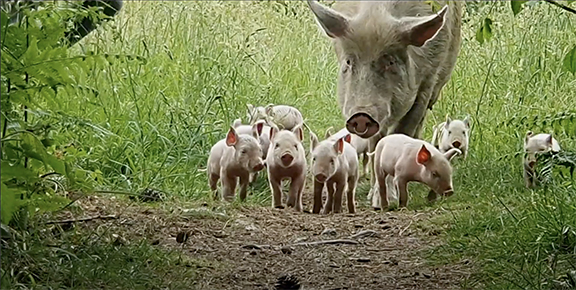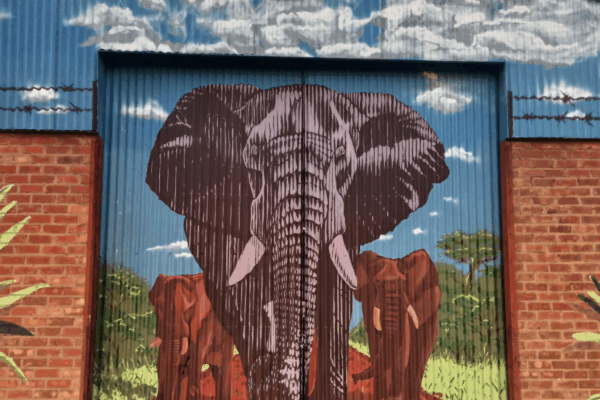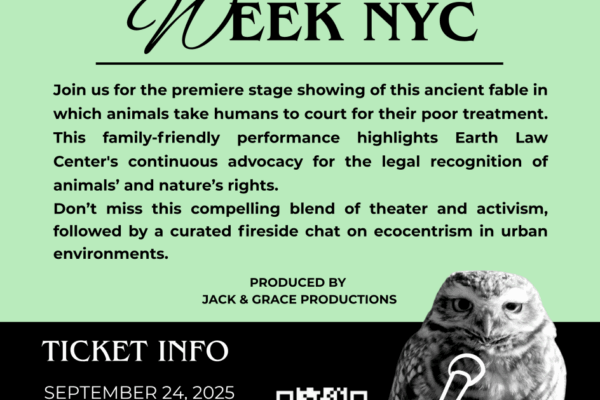When Pigs Escape is a documentary film by Jusep Moreno, a 2022 CAF grantee.
When Pigs Escape
An Interview with Jusep Moreno
Catalan filmmaker Jusep Moreno’s latest film is When Pigs Escape, a documentary about Matilda and her piglets, who escape from a farm in the U.K., and are rescued by a sanctuary. CAF associate Brooke Rucker interviewed Jusep, a 2022 CAF grantee. The interview has been edited for length and clarity.
Brooke Rucker (BR): This documentary was a truly inspiring and beautiful story of resilience. Why did you want to make this film, or what about this specific story inspired you?
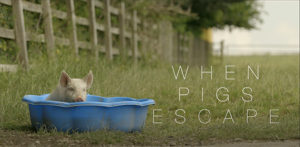 Jusep Moreno (JM): Sometimes when making films, we have a specific idea already in mind for the story we want to tell, but with this film, there was no way for me to know beforehand, and I didn’t even expect to be making this film. One thing about this story that was especially inspiring was Matilda herself, and I felt as if I had the skills to make her story last longer in order to inspire other people. I also wanted to make this film because of pigs themselves. Pigs are quite close to my heart. Having heard how they’re spoken about, and how far those descriptions are from the truth, making a film about them felt a nice thing to do. Pigs are some of the most abused animals on this planet, and part of the problem is that people are very disconnected from this issue. One purpose for this film is to bring people closer to pigs, to give people an opportunity to see them for who they are in a context where they are not being exploited, where they’re not in a farm, or where they’re not going to be killed for food.
Jusep Moreno (JM): Sometimes when making films, we have a specific idea already in mind for the story we want to tell, but with this film, there was no way for me to know beforehand, and I didn’t even expect to be making this film. One thing about this story that was especially inspiring was Matilda herself, and I felt as if I had the skills to make her story last longer in order to inspire other people. I also wanted to make this film because of pigs themselves. Pigs are quite close to my heart. Having heard how they’re spoken about, and how far those descriptions are from the truth, making a film about them felt a nice thing to do. Pigs are some of the most abused animals on this planet, and part of the problem is that people are very disconnected from this issue. One purpose for this film is to bring people closer to pigs, to give people an opportunity to see them for who they are in a context where they are not being exploited, where they’re not in a farm, or where they’re not going to be killed for food.
BR: Another question for you. Pigs seem to be very cinematic characters. There’s Babe, of course, and there’s also the individuals in 2017’s The Last Pig, and Gunda in 2020. What do you think makes pigs interesting from a cinematic perspective?
JM: People often compare pigs with dogs because of their intellectual capabilities, social behaviors, and perceptible communication with humans. Cinematically, pigs have a wide variety of behaviors that make them interesting to film, including mud baths. In the film, we watch Matilda having a mud bath, which helps her to keep cool in the heat. They are also aesthetically beautiful with their big snouts and ears, which is just another reason I enjoy filming them.
BR: I noticed that throughout the film, a lot of the natural audio was preserved and you used hardly any music. Why did you choose to do this, from a directorial perspective?
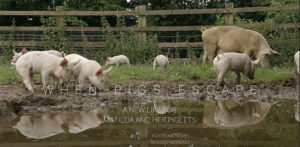 JM: I noticed as I was filming the pigs the unbelievable sounds they were making. One episode especially stuck me: when some of the piglets went to play with Matilda’s nose, and the noise they made was just so high-pitched, I had to go back and make sure I hadn’t messed up the editing. My other reasoning for keeping the audio went back to my idea of bridging the gap between humans and pigs. If I have a human-produced music to portray a message and narration to provide some information to the viewers, that’s a human telling us about pigs. That is music made by humans making us feel something about the pigs, effectively lessening the connection between the viewer and the pigs. We had to use narration at some parts so it wasn’t confusing; but we tried to minimize it.
JM: I noticed as I was filming the pigs the unbelievable sounds they were making. One episode especially stuck me: when some of the piglets went to play with Matilda’s nose, and the noise they made was just so high-pitched, I had to go back and make sure I hadn’t messed up the editing. My other reasoning for keeping the audio went back to my idea of bridging the gap between humans and pigs. If I have a human-produced music to portray a message and narration to provide some information to the viewers, that’s a human telling us about pigs. That is music made by humans making us feel something about the pigs, effectively lessening the connection between the viewer and the pigs. We had to use narration at some parts so it wasn’t confusing; but we tried to minimize it.
BR: Were you surprised by anything you learned or saw as you were making this film?
JM: Before making this film, I had already volunteered at Brinsley Animal Rescue, the sanctuary that initially took in Matilda, for four years. Because of this, nothing was too surprising to me while I was making the film, even if I had learned a lot in the past when I started volunteering. I was able to come into this film with a lot of background knowledge. Despite this, we did have one unpredictable scene where we took Matilda’s nose-ring out. We didn’t know how she would react, or if we would even be able to get it out. I wasn’t sure how I wanted to film this because I only really had one try. But we did get the ring out, which certainly benefited her.
BR: In the film, you can see that, ultimately, with the nose-ring, she ended up being happy about it being removed and that its removal did improve her life, but you could also see her fear about initially taking it out. For another question, what has been the overall reaction of the audience to your film, and have you been surprised by any audience reactions?
JM: So far we’ve had a relatively small audience for the film, around 250 people in the U.K., but the general response has been very good. During Q&As, some people focus on how they enjoyed the cinematography, while some people praise the film for not being too “preachy.” When people think of animal rights films, they almost always think of really assertive messages that are right in your face. There is certainly a space for those kinds of movies, and they are important, but my intention with this film was not to tell people what to think or what to do. I wanted to let people see the pigs and then form their own opinions about what they’ve just watched. Ultimately, the big question is if people have changed after seeing this film. I can’t put the responsibility of changing people on myself, but if people will watch this film that I’ve created, then my work is done. I hope that this film will be a stepping stone for people changing how they think about pigs, or animals in general. The animal rights audience has also praised the film, which I was really happy about, because this film is very unlike the regular animal rights films that we see, full of slaughterhouse footage and the like. I’m glad that people could watch this and it put a smile on their faces.
BR: Critics can be so harsh, so I’m glad that the reaction has been so positive. For our next question, what did you hope to achieve by making this film?
 JM: In order for the message of this film to not be preachy or anything else negative, I had to minimize narration, which also was important for connecting the viewer with the pigs, as I was saying earlier. There is a risk of doing this, though, and it is a fear I still have. The last thing I want is for people to exit the film thinking, “Oh, that was nice,” and nothing else. I want people to enjoy the film, but that is not the most important thing about this documentary, and I wanted to be sure that my point was made clearly. The main thing I wanted to achieve was just putting this story out there so as many people as possible see it, because most people won’t have an opportunity to go to an animal sanctuary to interact with pigs, and I think this film is the next best thing. I would be lying if I wasn’t saying that I don’t want people to come out of the theater and that they have radically different thoughts about pigs and that they decide to take responsibility for their actions.
JM: In order for the message of this film to not be preachy or anything else negative, I had to minimize narration, which also was important for connecting the viewer with the pigs, as I was saying earlier. There is a risk of doing this, though, and it is a fear I still have. The last thing I want is for people to exit the film thinking, “Oh, that was nice,” and nothing else. I want people to enjoy the film, but that is not the most important thing about this documentary, and I wanted to be sure that my point was made clearly. The main thing I wanted to achieve was just putting this story out there so as many people as possible see it, because most people won’t have an opportunity to go to an animal sanctuary to interact with pigs, and I think this film is the next best thing. I would be lying if I wasn’t saying that I don’t want people to come out of the theater and that they have radically different thoughts about pigs and that they decide to take responsibility for their actions.
BR: I was wondering how you decided what parts of the story you wanted to tell, and if you struggled with making any cuts of content? I’m sure that’s a dilemma that most filmmakers face if they end up with too much footage and need to decide what’s most important.
JM: I started filming about a year and a half ago, and actually when I started filming was the same day that I started my research for this project, so it was a bit messy. I knew for certain that there were two events I wanted to film: Matilda’s nose ring being taken out, and the piglets at six months old, because this is the age they are usually taken to the slaughterhouse. When I filmed them at six months, it was right around Christmastime, and I realized that the piglets probably would have been used for a holiday meal, and that really stuck out to me. The rest of the process outside of these two events was essentially just me trying to film as much as possible, whenever I wasn’t at my other job and was able to go to the sanctuary. I ended up with a ton of similar footage, but luckily I had help sorting through all of it from my friends, family, people from the sanctuaries, and a student from London who just finished her degree in screenwriting. The editing took around eleven months even with all the help, even though the film only took about a month to film. The biggest difficulty was choosing which clips I wanted to keep, because all of them felt important, but there was just too much footage to keep all of it. I had to look at it objectively and see what worked and what didn’t work.
BR: Is there anything that you’d like to add?
JM: The only thing I want to say is thanks to everyone who has supported the film, even if they are not listed in the credits. I never could have made this film alone. We’ve also been able to submit to twelve or thirteen film festivals and have won a couple of awards, which would not have been possible without all the support. First of all, the Culture & Animals Foundation, you were the first ones to support the documentary. Also from the U.S., A Well-Fed World and the Pollination Project have stepped in to help us out. In the U.K., we’ve had the Animal Justice Project help us with the promotion of the film. Back home, the Centre for Animal Ethics in Barcelona also helped us with the promotion.
BM: Thank you for your time, Jusep, and for making When Pigs Escape!
JM: Thank you for your time and for the questions.


